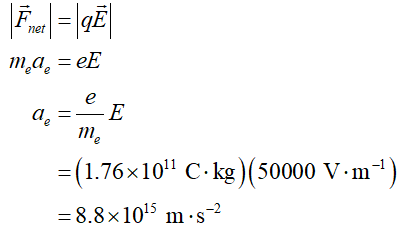An electron is fi red at a speed v0 = 5.6 x 106 m/s and at an angle θ0 = -45° between two parallel conducting plates that are D = 2.0 mm apart, as in Figure P16.68. If the voltage difference between the plates is ?V = 100 V, determine (a) how close, d, the electron will get to the bottom plate and (b) where the electron will strike the top plate.FIGURE P16.68
An electron is fi red at a speed v0 = 5.6 x 106 m/s and at an angle θ0 = -45° between two parallel conducting plates that are D = 2.0 mm apart, as in Figure P16.68. If the voltage difference between the plates is ?V = 100 V, determine (a) how close, d, the electron will get to the bottom plate and (b) where the electron will strike the top plate.
FIGURE P16.68
The electric field can be calculated as,

The acceleration for electrons can be calculated as below,

The direction of the acceleration is along vertically upward direction, as can be seen easily that acceleration is acting in the opposite direction of the electric field for electrons.
Now, if electron is fired making taking a 45º angle, the vertical velocity and the horizontal velocity can be calculated as below,

Since, the acceleration is in vertical direction therefore it acts only for the velocity’s vertical component,

Step by step
Solved in 7 steps with 7 images
